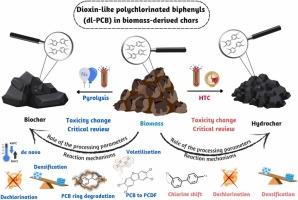Dioxin-Like Polychlorinated Biphenyls (dl-PCB) in Hydrochars and Biochars: Review of Recent Evidence, Pollution Levels, Critical Gaps, Formation Mechanisms and Regulations
IF 12.2
1区 环境科学与生态学
Q1 ENGINEERING, ENVIRONMENTAL
引用次数: 0
Abstract
Contamination of chars with dioxin-like polychlorinated biphenyls (dl-PCB) significantly limits their use and hinders their deployment in the circular bioeconomy, specifically in applications that may lead to dietary exposure. Here, for the first time, we review the levels of contamination of chars produced from pyrolysis and hydrothermal carbonisation (HTC) with dl-PCB congeners. We conduct a detailed and critical examination of the role played by the processing parameters, such as temperature and residence time, and the reaction mechanisms, to detoxify the biomass under an oxygen-free atmosphere during its valorisation. The PCB-based toxicity of biomass depends mostly on the abundance of dl-PCB in the raw material, and on the dechlorination and other transformation processes that operate during the treatment. The key dechlorination steps make the toxicity of hydrochars pass through a maximum with increasing treatment time, whereas the toxicity of biochars in pyrolysis decreases monotonically. Pyrolysis displays more complex mechanistic pathways of volatilisation, dechlorination, degradation of PCB rings, minor de novo formation of dl-PCB in case of air leaks, and concentrating persistent organic pollutants (POP) in char matrices. In contrast, the mechanisms responsible for the evolution of toxicity in HTC processes comprise the dechlorination, possible chlorine position shift, and biomass densification. The kinetic model developed in this review affords insight into the evolution of the hydrochar toxicity that depends on process temperature and treatment time. The dl-PCB concentrations in treated biomass generally range from 1.06 ng WHO2005-TEQ (kg DM)-1 to 11.7 ng WHO2005-TEQ (kg DM)-1, whereas for biochars produced from contaminated sediments the toxicity varies from 0.00662 ng WHO1998-TEQ (kg DM)-1 to 1.42 ng WHO1998-TEQ (kg DM)-1. DM stands for dry matter, TEQ for toxic equivalency, and WHO1998 means the application of the toxic equivalency factors (TEF) set by the World Health Organization (WHO) in 1998 to calculate the TEQ. Finally, we identify the crucial gaps in the literature, review the regulations governing the use of biomass in feed and in the environment, and provide suggestions for future research. The findings in this article provide both the technical understanding of how to minimise the formation of dl-PCB in the production of chars and suggest modifications to the current guidelines. The latter will increase the consumer’s trust in valorised biomass, leading to its wider acceptance in the circular bioeconomy as feed supplements and soil additives.

水煤浆和生物煤浆中的二恶英类多氯联苯(dl-PCB):最新证据、污染水平、关键差距、形成机制和法规综述
木炭受到二恶英类多氯联苯(dl-PCB)污染极大地限制了其使用,阻碍了其在循环生物经济中的应用,特别是在可能导致饮食接触的应用中。在此,我们首次回顾了热解和热液碳化(HTC)产生的炭中 dl-PCB 同系物的污染水平。我们对加工参数(如温度和停留时间)和反应机制所起的作用进行了详细而严谨的研究,以便在无氧环境下对生物质进行无害化处理。生物质中的多氯联苯毒性主要取决于原料中 dl-PCB 的丰度以及处理过程中的脱氯和其他转化过程。随着处理时间的延长,关键的脱氯步骤会使水成渣的毒性达到最大值,而热解过程中生物渣的毒性则会单调下降。热解过程中的挥发、脱氯、多氯联苯环的降解、空气泄漏情况下二氯多氯联苯的少量重新生成以及持久性有机污染物(POP)在炭基质中的富集等机制途径更为复杂。相比之下,在 HTC 过程中,造成毒性演变的机制包括脱氯、可能的氯位置转移和生物质致密化。本综述中开发的动力学模型有助于深入了解水煤浆毒性的演变过程,这种演变过程取决于工艺温度和处理时间。经处理的生物质中的 dl-PCB 浓度一般在 1.06 ng WHO2005-TEQ (kg DM)-1 到 11.7 ng WHO2005-TEQ (kg DM)-1 之间,而从受污染的沉积物中生产的生物炭的毒性则在 0.00662 ng WHO1998-TEQ (kg DM)-1 到 1.42 ng WHO1998-TEQ (kg DM)-1 之间。DM 表示干物质,TEQ 表示毒性当量,WHO1998 表示采用世界卫生组织 (WHO) 于 1998 年制定的毒性当量因子 (TEF) 计算毒性当量。最后,我们指出了文献中的重要空白,回顾了有关饲料和环境中生物质使用的法规,并为未来的研究提出了建议。本文的研究结果既从技术上说明了如何在木炭生产过程中最大限度地减少二氯丙醇的形成,又对现行准则提出了修改建议。后者将增加消费者对有价生物质的信任,从而使其作为饲料补充剂和土壤添加剂在循环生物经济中得到更广泛的接受。
本文章由计算机程序翻译,如有差异,请以英文原文为准。
求助全文
约1分钟内获得全文
求助全文
来源期刊

Journal of Hazardous Materials
工程技术-工程:环境
CiteScore
25.40
自引率
5.90%
发文量
3059
审稿时长
58 days
期刊介绍:
The Journal of Hazardous Materials serves as a global platform for promoting cutting-edge research in the field of Environmental Science and Engineering. Our publication features a wide range of articles, including full-length research papers, review articles, and perspectives, with the aim of enhancing our understanding of the dangers and risks associated with various materials concerning public health and the environment. It is important to note that the term "environmental contaminants" refers specifically to substances that pose hazardous effects through contamination, while excluding those that do not have such impacts on the environment or human health. Moreover, we emphasize the distinction between wastes and hazardous materials in order to provide further clarity on the scope of the journal. We have a keen interest in exploring specific compounds and microbial agents that have adverse effects on the environment.
 求助内容:
求助内容: 应助结果提醒方式:
应助结果提醒方式:


